North America is home to a broad variety of temperatures and ecosystems, from the arctic tundra of Canada to the tropical rainforests of Mexico.
Owls are widespread and diverse in appearance, size, and behavior.
Different kinds of owls may be found just about everywhere in the United States, Mexico, or Canada.
You may find a variety of owls throughout North America, but these are among the most frequent.
In this article, I have listed 17 Types of Owls in North America.
| Image | Name |
|---|---|
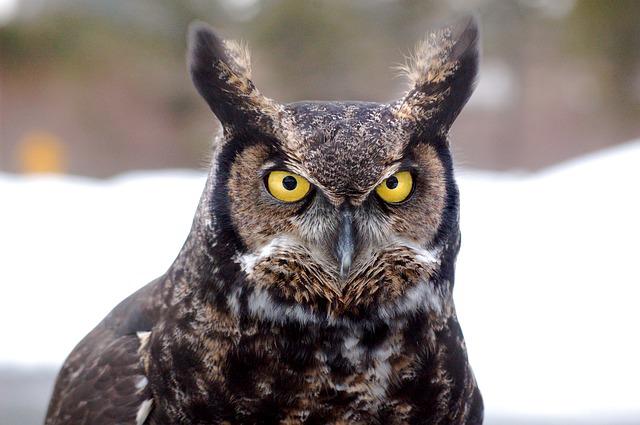 | Great Horned Owl |
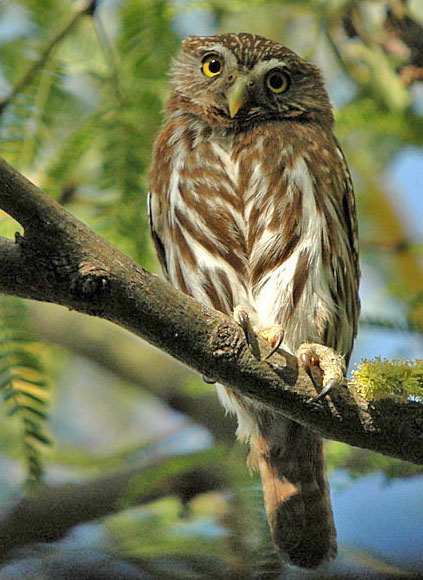 | Ferruginous Pygmy Owl |
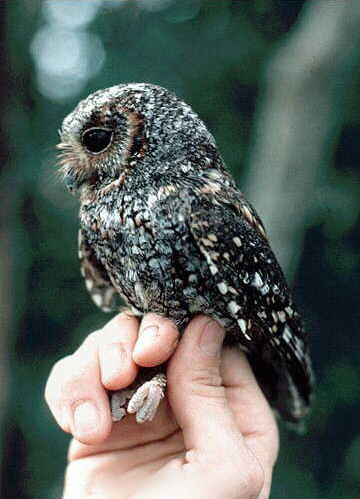 | Flammulated Owl |
 | Northern Hawk Owl |
 | Short-eared Owl |
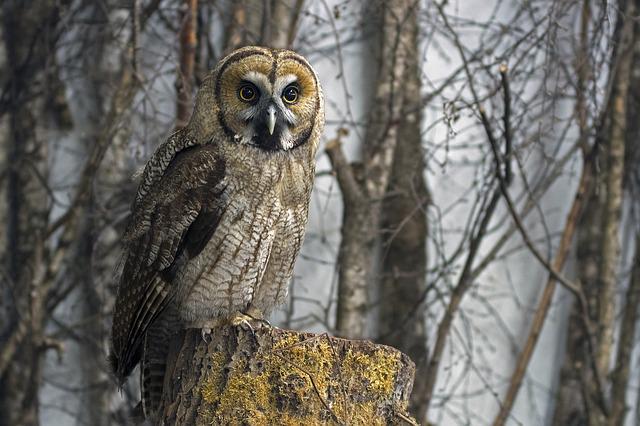 | Great Grey Owl |
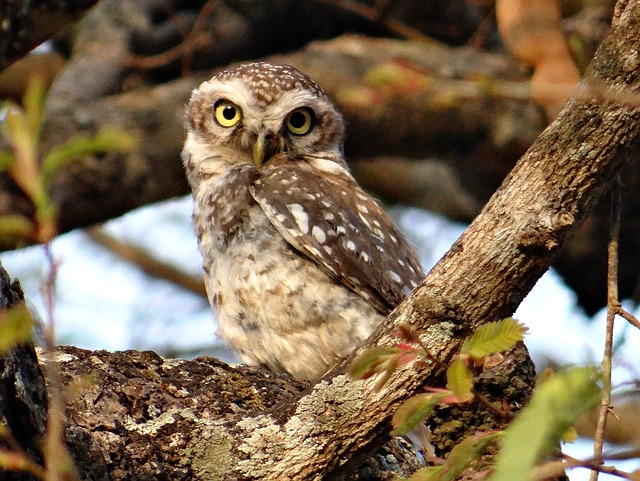 | Northern Spotted Owl |
 | Boreal Owl |
 | American Barn Owl |
 | Snowy Owl |
 | Barred Owl |
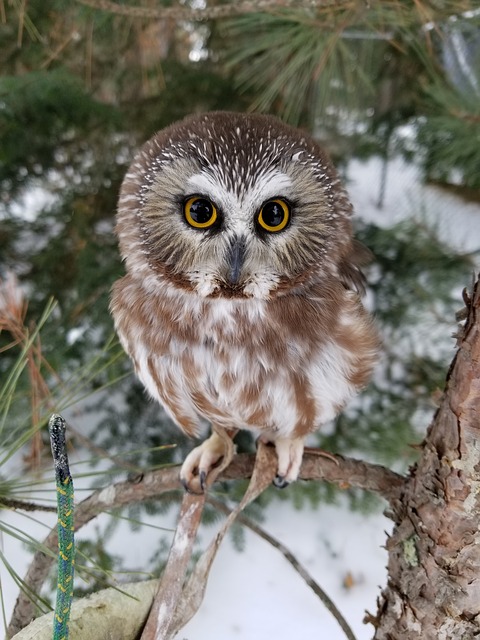 | Northern Saw-Whet Owl |
 | Screech Owl |
 | Burrowing owl |
 | Long-Eared Owl |
 | Elf Owl |
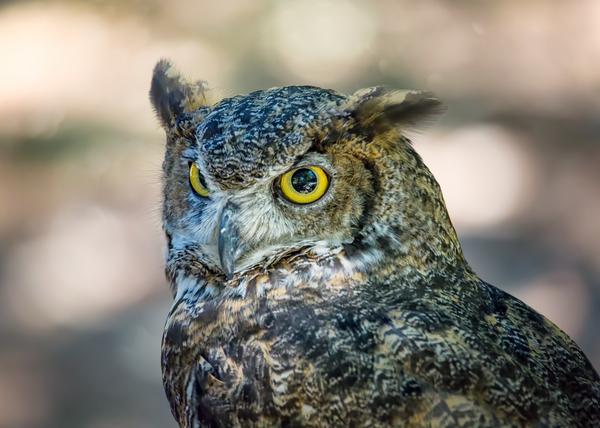 | Northern Pygmy Owl |
Types of Owls in North America
1. Great Horned Owl

The Great Horned Owl may be found in any part of the United States that seems to have trees and rocky areas suitable for nesting.
Among the most adaptive owls, their range encompasses all of North America.
This species of owl is strictly nocturnal. They are unable to fit into natural nesting cavities because of their size.
The Great Horned Owl is too big to nest in a box, so if you want to understand how to attract owls, you’ll have to go elsewhere.
Great Horned Owls get their name because of the tufts of feathers that stand straight up on top of their heads, offering them the looks of horns.
Food
Since it is one of the biggest owls across North America, the Great Horned Owl prefers to feast on bigger prey.
While mice and snakes are on the menu, geese, ducks, and rabbits are also favorites.
2. Ferruginous Pygmy Owl

The Ferruginous Pygmy Owl is an endangered species in the United States despite spending most of its time in Mexico.
Fortunately, they may still be found in large numbers across South and Central America.
They are occasionally spotted throughout deserts dominated by saguaro cacti and mesquite forest areas along rivers in the southwestern United States.
Food
In contrast to other kinds of owls, the ferruginous pygmy owl is often seen going about its business during the day.
They consume things like lizards, insects, songbirds, and small animals for food.
They are permanent inhabitants of a few isolated areas in the states of Arizona and Texas, but their numbers are very low, and their populations are falling.
3. Flammulated Owl

The name “Flammulated” comes from the word “flame,” and once you see a Flammulated Owl, you’ll know why it was given that moniker.
The Flammulated Owl has feathers that are the color of an ash-covered log.
Habitat
Flammulated owls like to make their home in dense, evergreen forests, where they can find the safety of the highest branches.
Once in a while, they’ll even make a home in a deciduous forest, so long that there are a few conifers there, too.
They raise their young in tree holes despite the absence of any conceivable nesting materials.
Flammulated Owls can only be found in small, remote areas of the West and Southwest of the United States.
The tiny insects make up the bulk of their food.
The Flammulated Owl’s disproportionately large cry belies its little stature.
The Flammulated Owl may seem little, but its cry resembles the sound of a much bigger bird.
4. Northern Hawk Owl

In the lower 48 states, the Northern Hawk Owl is a very uncommon bird.
They are seen significantly more often over the whole of Alaska and Canada.
Because they are active during the day, Northern Hawk Owls are a bit of an oddity in the animal kingdom.
They do most of their hunting during the day, so they are able to identify their prey through sight even though their hearing is not as sharp as that of other species of owls.
They have the habits of a hawk while having the appearance of an owl. Because of this, the name.
This owl is about the size of a barn owl and has an oval body with a long tail that tapers off at the end. It also has horizontal stripes on its chest.
Habitat
It is able to be spotted during the day and prefers to hunt for its food while perched on the tops of solitary trees.
Range
These owls spend the majority of their lives in the boreal forest areas of Canada, but they have been known to spend the winters in the northern parts of the United States.
They travel south in search of food because the number of their kind in Canada has decreased.
5. Short-eared Owl

Typically endemic to the northeastern United States, Short-eared Owls have been documented as far north as Northern Canada and Alaska for nesting purposes.
Occasionally, small groups of Short-eared Owls may fly all the way to Mexico to spend the winter.
They like to hunt low to the earth across broad fields and plains.
The Pueo Owl is a variant of the Short-eared Owl. The Pueo owl is an indigenous Hawaiian bird.
Their numbers, however, are steadily decreasing.
Behavior
Crepuscular means that Short Eared Owls are active both during the day and during the night.
Their appetites are as brutal as their behavior, and they will only consume the meat after first cutting the heads and internal organs.
They are mostly carnivorous, feasting on birds and small animals.
These owls often prefer open regions for nesting, where they may perch and watch their prey.
As a ploy to distract predators, they may flop about the area around the nest as if hurt.
A Short-eared Owl’s cry resembles that of a cat going through estrus.
6. Great Grey Owl

The Great Grey Owl is said to be difficult to see by bird watchers due to the fact that it is a very private animal.
They are very reclusive, and their natural habitat in the United States is restricted to the arctic woods that are found in the most remote mountainous areas of the country.
Another kind of owl, this one, does not nest in cavities and does not construct its own nests. Neither does it use its own materials.
Instead, they make use of ancient nests that have been abandoned by other birds, etc.
The Great Horned Owl and the Snowy Owl both weigh more than these birds; however, these owls weigh less overall despite having the longest feathers of any owl in the United States.
The daily diet of one of these owls must consist of around seven or eight huge voles in order for it to be sufficient for the bird to maintain its vigor.
In most cases, they hunt just before dawn and right before sunset.
7. Northern Spotted Owl

The Northern Spotted Owl, the California Spotted Owl, and the Mexican Spotted Owl are the three subspecies that make up this owl’s overall species.
Range
However, in addition to its native Mexico, the Mexican Spotted Owl maintains a sizable and stable population in the neighboring states of Arizona, New Mexico, Colorado, and Utah.
The spotted owl’s behavior is little understood.
Despite their rarity in the wild, spotted owls are at risk because their habitat is being destroyed.
Partners in Flight estimates that there are 15,000 breeding pairs around the world. Of them, 4% are Canadian, 56% are American, and 40% are Mexican.
8. Boreal Owl

The Boreal Owl is a nocturnal bird that can only be found in the boreal woods of North America, which is exactly where you would expect to find it, given its name.
Because of this, and you’ll see a Boreal Owl throughout the United States, you will most likely have to go to the state of Washington, the state of Alaska, or the state of Idaho in order to have a chance of doing so.
They tend to congregate in the northernmost parts of the continent.
Food
The majority of the owls’ diet consists of rodents that may be spotted in the forest, and they hunt by performing dive attacks.
The Boreal Owl is a species that like to roost in cavities, and if provided with one, it would gladly construct its home there.
If you live in the area where it is found, you may want to consider putting up an owl box since you never know what kind of luck you could have.
Every night, Boreal Owls choose a new location to rest in a different tree.
They find it most relaxing to spend the day dozing off in the shade of towering fir trees, around 15 to 21 feet from the ground.
9. American Barn Owl

In addition to the keen eyesight for which owls are famous, American Barn Owls also possess extraordinary hearing.
They have the incredible ability to track down their prey using just sound.
Habitat
Barns, silos, sheds, and other man-made structures are all suitable homes for the American Barn Owl.
They don’t move about but rather remain in the same area all year.
They avoid the mountains but are widespread in the plains and farmlands of the North American continent.
There are two owl species in Hawaii, and one of them is the Barn Owl.
The animals were brought to the islands from elsewhere and are thus not native to them.
The American Barn Owl is a stunning owl of a more moderate size.
Their faces are white, but the rest of their bodies are a rainbow of hues.
Their features are heart-shaped. These owls are nocturnal hunters and unless your ducks and chickens aren’t safely fenced in, they won’t pose much of a danger to them.
10. Snowy Owl

When you encounter a Snowy Owl, it is easy to see where the name came from since this owl is all white and is among the most striking birds of prey.
It should come as no surprise that Snowy Owls inhabit regions that get a significant amount of snow, given the coloration of their feathers.
These regions include North Dakota, Alaska, Montana, South Dakota, and the area around the Great Lakes.
On the other hand, in the event that an abnormal weather pattern develops over the United States, Snowy Owls may go as far south as Texas.
Behavior
As a result of the fact that Snowy Owls typically hunt during the day, it is possible to see this species very regularly in the locations in which it resides.
They like hunting in open areas, such as shorelines and fields, from where they may attack their prey from above.
The nesting habitats of these owls are jealously guarded by the birds, who often return to the same location year after year to construct their nests.
11. Barred Owl

The parallel dark-brown and light-brown stripes on a Barred Owl’s body are what give the species its name. Contrary to popular belief, these owls are not as timid as others.
They’ll be keeping an eye on you just as closely as you’re keeping an eye on them.
A barred owl is almost certain to be around if you hear a call that sounds like, “Whoo cooks for you?” at night.
These owls are just somewhat shorter than the Great Horned Owl, yet they still prey on anything that isn’t as big as themselves.
Formerly confined to the East Coast, these owls may soon be seen in every one of the United States thanks to the expansion of their habitat.
Although they are mostly nocturnal, Barred Owls have been seen hunting and making calls during the day.
These birds are most at home in dense forests with a few clearings here and there.
They like wet, marshy environments with big trees.
12. Northern Saw-Whet Owl

This owl’s name may lead you astray in more ways than one.
The Northern Saw-Whet Owl is not restricted to the northern regions of the United States but may be found across the country.
These adorable young owls do, however, go to more northern regions in order to reproduce there.
These owls are among the tiniest species of owls seen anywhere in the world.
Habitat
These little owls make their nests in densely forested places, and they build their nests in the tallest trees possible so that they have an excellent view of the landscape around them.
They are cavity nesters and, therefore, will nest in holes already present in trees that have been abandoned.
The Northern Saw-Whet is a nocturnal mammal that preys on insects, rodents, and birds of a smaller size.
Because of this, the Northern Saw-Whet has a characteristic call that may be heard throughout the night.
13. Screech Owl

There are three distinct subspecies of screech owls that may be found in the United States.
The Western Screech Owl, the Whiskered Screech Owl, and the Eastern Screech Owl are their respective names.
The Screech Owl is a misnomer since the animal does not make a screeching sound.
When they’re active at night, they communicate with one another using a variety of calls, some of which have a bit of a screechy quality, but for the most part, their sounds are rather smooth.
Range
The Eastern Screech Owl may be found throughout practically the whole Central and Eastern United States, but Western Screech Owls are only present in the Western regions of the United States.
The Whiskered Screech Owl and the Western Screech Owl are quite similar in appearance and inhabit many of the same habitats.
Screech Owls like to live in wooded regions that are located close to sources of water, such as streams and rivers, for their habitat.
Putting up nest boxes may entice screech owls to move into certain parts of the country.
They are known to consume rodents, lizards, snakes, and even other birds of a smaller size, which makes them desirable for homesteads.
14. Burrowing Owl

Burrowing owls are among the most peculiar types of owls since they make their home below, in tunnels that they have constructed themselves.
Food
The legs of these owls are rather lengthy. They forage for food on the ground throughout the day.
They hunt insects, rodents, and small birds for a living and make their homes in open environments such as prairies, grasslands, and deserts.
The plains and deserts of the Western United States are home to Burrowing Owls. In addition, there are thriving populations of them in Southern Florida.
They choose areas that have a great deal of available open space.
Burrowing Owls are unique among owls in that they are known to bury caches of their kills underground.
Researchers have discovered tunnels that contain the remains of dozens of mice that the Burrowing Owl had hidden away for future consumption.
15. Long-Eared Owl

Long-Eared Owls always have astonished expressions on their faces due to the large feather tufts that are located on the sides of their heads.
This particular species of an owl does not nest in cavities.
They prefer open nests to closed ones. On the other hand, they do not construct their own nests.
They achieve this by using the nests of other animals, such as squirrels or other birds, that have been abandoned by their young.
Because of their extreme timidity, many individuals have never had the opportunity to witness a Long-Eared Owl.
On the other hand, their unique cries may be heard around one mile away from them.
They like to forage on open terrain, but they make their nests in thick brush.
Although they may be found in most sections of the United States, Long-Eared Owls make their homes in the northern portions of both the United States and Canada.
16. Elf Owl

The Elf Owl is the species of owl that is the smallest overall.
The size of these owls is comparable to that of a sparrow.
Elf Owls have a length of around 5 inches (13 centimeters) and weigh between 1.2 and 2.1 ounces (35 to 56 grams).
The Elf Owl is native to Texas and may also be seen in the deserts of Northern Mexico and the Southwestern United States.
Food
It consumes a variety of desert invertebrates, such as insects, moths, centipedes, and other insects and arthropods.
They hunt their prey under the darkness of the night while flying stealthily and in complete silence.
Because of the kind of plumage that are located on the sharp end of their wings, these birds are able to glide through the air in complete silence.
Elf Owls are nocturnal birds that make their homes in the hollows of cacti and older trees.
They are seldom seen during the day. If you catch an elf owl, it will pretend to be dead until it is freed again.
17. Northern Pygmy Owl

The Northern Pygmy Owl is a species of owl that is widely seen in the western mountainous parts of the United States.
This is because the Northern Pygmy Owl is active throughout the day, making it easy to spot.
The Northern Pygmy Owl is a species of owl that is very small. It is just somewhat bigger than a house sparrow.
It sits still, keeping a watchful eye out for an opportunity to pounce on its target.
Food
These birds get the majority of their nutrition from insects, lizards, and other small birds and rodents.
They will only nest in holes that have been naturally formed and will avoid nesting in buildings that have been created by humans.
In general, the Northern Pygmy Owl is most comfortable in dense woods that are in close proximity to open areas where it may follow prey.
Conclusion
It is possible that you already see some of these birds of prey in your yard if you reside in an area with plenty of trees or other thick vegetation.
Even though most of them are active at night, there are some daytime hunters.
With that stated, this concludes our essay on the astonishing variety of owls found in North America.
We hope you might find this checklist of North American owls both informative and entertaining.
FAQ
Which owl species is the most prevalent throughout the Americas?
Of all the owl species found in North America, the great horned owl is among the most common and well-known. Wow, what a demanding client! Among owl species, great horned owls get the widest variety of prey items they regularly consume. Birds, including waterfowl and raptors, are fair game for these creatures.
Exactly how uncommon is it to spot an owl?
Perhaps the rarest owl in the world is the Blakiston’s fish owl. Due to widespread extinction, the Blakinston’s Fish owl—also the biggest owl species—may now be the rarest owl throughout the world.
Last Updated on March 22, 2023 by Lily Aldrin
